Gardening is an enjoyable and rewarding hobby, but it can also be quite frustrating. One of the most common frustrations people have when gardening are insects. Whether you’re dealing with pesky bugs that eat your plants or you just want to keep pests away from your vegetables, garden screening can help. There are many types of screening available for gardens, but how do you know which one will work best in your situation?
In order to get started choosing a garden screen, first, you’ll need to decide whether you’d like to use mesh or solid screening material. Mesh screens are often considered to be the more affordable option, but they tend to allow more light into your garden which isn’t always desirable. Solid screens, on the other hand, block more light than mesh screens, but you may find yourself having less problems with insects.
The next step is deciding between aluminum or plastic. Aluminum is typically considered to be the better choice because it doesn’t rust and won’t break down as easily over time. Plastic, however, is lighter-weight and can be used indoors. If you plan on using a garden screen inside, aluminum is often the better choice.
Next, you’ll need to consider whether you’ll be installing the garden screen permanently or if you’ll be removing it at the end of each growing season. Permanent screens don’t require any tools to install while removable screens must be removed so they can be cleaned or replaced. Removable screens are usually preferred by homeowners who plan to remove them after the summer months.
Finally, you’ll want to look for a screen that’s easy to install, yet durable enough to withstand harsh weather conditions. The type of screen you choose should match your particular needs. For example, if you live in an area where heavy winds and rain are common, then you’ll probably want to go with a higher-quality screen that’s stronger than those made of lower-quality materials.

Types Of Garden Screens
There are several different kinds of garden screens available today. They range from mesh screens that are designed for outdoor use, to portable screen walls that can be installed anywhere around your home. In addition, there are also permanent and semi-permanent screens available.
Mesh screens are generally thought of as being the most inexpensive type of screen. They can be purchased in both 6 inch and 12 inch widths and come in either 4 foot lengths or 8 foot lengths. While these screens are great for keeping out bugs, they also let too much light through which can be problematic if you’ve planted flowers that bloom during the day.
A solid screen, on the other hand, blocks all light but allows airflow, which means you can still enjoy natural sunlight without worrying about bugs. It also makes it easier to clean up leaves and debris. These screens come in 4 x 8 feet sizes and are usually constructed out of high-grade plastic.
Portable screens are designed to be moved around your yard throughout the year. This type of screen is ideal for covering flower beds, patios, or even pathways. You can move it from place to place and set it up wherever it works best for your gardening needs. Portable screens are available in a number of different styles including collapsible screens, folding screens, and roll-up screens. They can be purchased in both aluminum and plastic versions and come in widths ranging from 2-4 inches wide.
Permanent screens are usually much sturdier than their portable counterparts. They’re meant to last longer and can usually be installed anywhere in your yard. There are many styles available and they’re commonly made out of metal, wood, or concrete. You might also run into some screens made of recycled materials such as old fence pieces or railroad ties.
Installation Options
Once you’ve decided on the style, size, and material of your screen, you’ll need to determine the installation method. Most screens are made to be attached to something else, whether it’s a wall, fence, trellis, or patio post. Some screens are available with clips or brackets that make it possible to attach them directly to the ground.

Another popular installation technique involves attaching the screen to a post then planting the post in the ground. You can then plant your trees or shrubs around the post and it becomes part of the landscape instead of another ugly object in the yard. However, this technique requires you to dig holes for the posts and requires special tools to create the holes.
If you’re planning on installing the screen indoors, then you’ll need to purchase a portable screen that can be assembled and disassembled. A good alternative is to purchase a portable shed or greenhouse that already has a built-in screen.
If the person will get eth basic idea of the Beautiful screens in the garden they will have to face with fewer problems. The person should try to go for the option that is of the best quality and available reasonably. Having quality on the screen matters the most.
Conclusion
Deciding what kind of screen to buy for your garden can be overwhelming, especially since there are so many different options out there. Once you’ve got an idea of what you want to accomplish, though, you’ll be able to narrow down the choices and make a decision that fits your particular needs. And once you’ve chosen what you’re looking for, it’ll be a lot easier to find a screen that fits your budget and lifestyle.





